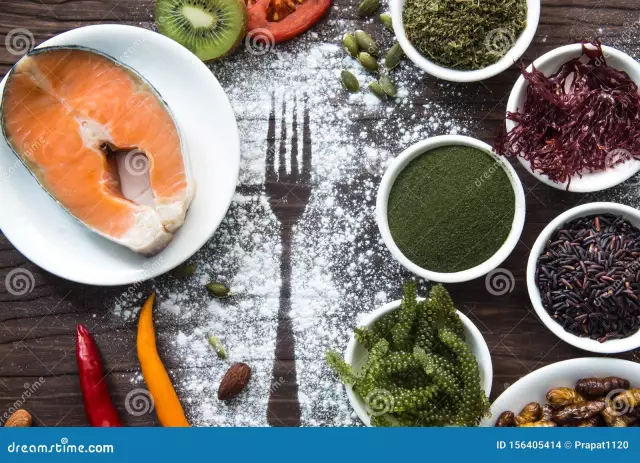- Author Rachel Wainwright [email protected].
- Public 2023-12-15 07:39.
- Last modified 2025-11-02 20:14.
Food of the future: 7 new types of food
The number of humanity is growing every year. By the middle of this century, there will be about 9 billion of us. The problem of a sufficient amount of food is becoming more and more acute, and scientists are forced to intensify research on the creation of new food products that are simple to grow and manufacture, affordable and have decent consumer qualities.
We will tell readers about food that is still exotic, but may well become familiar to our grandchildren.

Source: depositphotos.com
Laboratory meat
Despite the assurances of vegetarians, most people still eat meat regularly. It's not just about eating habits: animal proteins contain substances without which the body cannot function normally and which cannot be obtained from other sources.
However, do not forget that the production of meat products is very costly and harmful to the environment. Scientists argue that making artificial meat analogs will significantly reduce energy costs, land exploitation and greenhouse gas emissions.
Attempts to produce synthetic meat have been made for a long time. Over the past decades, progress has been made in this area: American scientists have been able to obtain a product similar to beef, using stem cells for its production. The technology is still quite expensive and not completely debugged, so affordable and high-quality synthetic steaks will not appear on the market until 2030.
Fish from the farmer
For coastal countries, fishing is the main way to obtain food protein. Unfortunately, due to many years of industrial production, certain species of sea and river inhabitants are on the verge of destruction, and international organizations were forced to impose strict restrictions on fishing.
According to scientists, the future of this industry is associated with the development of fish farming, especially since this method of protein production is much more efficient than raising cattle, and is not associated with the exploitation of vast tracts of land.
Fish substitutes
Recently, experiments on the production of synthetic analogs of fish and seafood have been actively carried out. For example, American scientists managed to obtain a full-fledged fish fillet by introducing the cells of the muscle tissue of goldfish into the blood serum of embryos of calves. Another line of research is related to attempts to synthesize shrimp meat based on seaweed tissues. There is every reason to believe that sooner or later artificial seafood will hit consumers' tables.
Seaweed
Residents of regions with access to the ocean constantly include red and blue-green algae in their diet. However, this time we will not talk about them, but about their unicellular cousins. These babies are unpretentious and capable of producing in record time a product rich in carbohydrates, proteins and fats and quite suitable for human nutrition. In addition, some types of microscopic seaweed contain Omega-3 fatty acids, which are essential for our health.
Studies of the possibility of using unicellular algae in the food industry have been carried out in recent years. One of the American firms has already offered customers flour with similar additives.
Insect products
Insect dishes are traditional in Asian and African cuisine. Popular foods include grasshoppers, wasps, bees, dragonflies, tarantulas, beetles, water and grass bugs, as well as larvae of many species. This is not surprising: this food is affordable and nutritious, since insect tissues are rich in complete protein, while other types of protein foods (for example, cattle meat) in these regions are expensive.
European shoppers who are not used to this kind of food will have to gradually accustom themselves to insect products. Pasta made from flour with the addition of dried and chopped grasshoppers has already appeared on the market. Food design projects are being developed that include mealworms as a source of inexpensive fats.
GMO products
Genetically modified organisms (GMOs) are now part of our life. Despite the objections of opponents, potatoes, soybeans, rapeseed, corn and other crops, the properties of which were corrected by means of a directed genome change, are now actively used in food production. This happens not only because GMO plants are more productive, cheaper and better than their traditional counterparts. A significant role in the widespread use of genetically modified products was played by the fact that the harm to health that they allegedly cause was never detected.
In the near future, on our tables there will be new varieties of fruits that can be stored for a long time without any processing, as well as meat from pigs that are resistant to viral infections.
Food made with a printer
3D printing will soon become commonplace for everyone. Now this method is used mainly for the manufacture of plastic items. By replacing raw materials with food mixes, real food can be printed on a 3D printer. Particularly appealing about this idea is that food can be cooked as needed, which means they will always be fresh. In addition, it will be possible to adjust the texture of the "printed" food so that it is convenient for people who have problems with chewing and swallowing (elderly, sick, etc.). The time when a 3D printer becomes the main kitchen appliance is not far off.
Nature created us not only omnivores, but also intelligent. This means that humanity should work on its eating habits and the correct use of the resources of its home planet. If it approaches the problem correctly, fears about the onset of global hunger can be safely said goodbye.
YouTube video related to the article:

Maria Kulkes Medical journalist About the author
Education: First Moscow State Medical University named after I. M. Sechenov, specialty "General Medicine".
Found a mistake in the text? Select it and press Ctrl + Enter.






